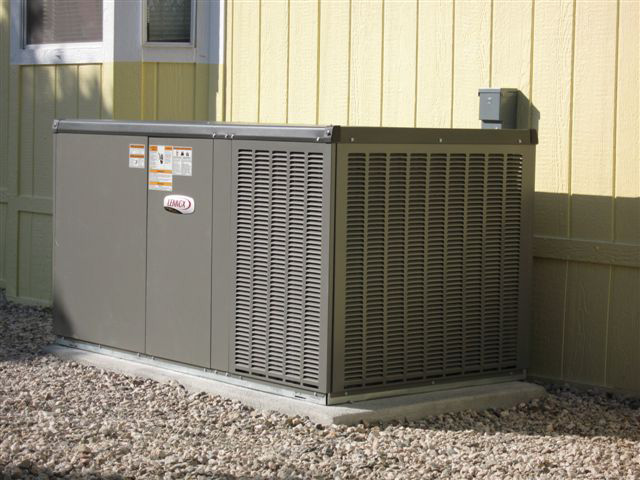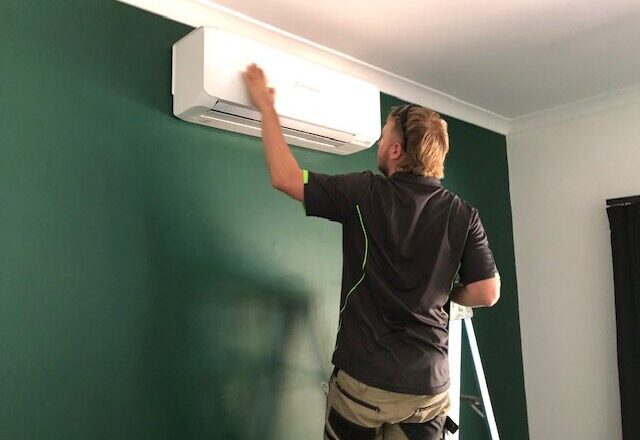Despite all its advantages, the air-conditioning effect of a ventilation system is limited. When it comes to lowering the temperature by a few degrees in summer, building owners and renovators have to resort to special air-conditioning units. As these consume electricity, they put a strain on the energy balance of a house and are provided with corresponding surcharges in the Energy Saving Ordinance. Special care is necessary with the planning of winter gardens. Heat-insulating windows help to keep temperatures within tolerable limits.
In hot summers mobile air conditioners are in some weeks true sales racers. They lower the room temperature by a few degrees and can also be used as humidity regulators. In order for the appliances to fulfil their cooling function, the heat must be able to be dissipated to the outside. For this purpose, a flexible pipe is hung from the window (tilted or a gap opened). Operation of the air conditioners is simple. The removal of heat via the windows, however, ensures that there is a constant flow of warm air and reduces efficiency. The consumer centres therefore warn against the high energy consumption and electricity consumption of these devices.
Mobile air conditioners
Mobile air conditioners are available in the compact version and as split units. The mobile compact versions are sufficient for rooms from 20 to 22 square metres. Split units are used in larger rooms. These consist of an indoor unit and an outdoor unit, connected by prefilled refrigerant lines. Split air conditioners are not only more powerful, they also have the advantage that the more noisy parts are located outside, for example on the balcony or terrace. The indoor units run very quietly (sometimes 25 decibels or less, which is quieter than whispering). In addition, the devices can be installed on the ceiling, wall or floor, and a lot has also happened in terms of design in recent years. For example, there is a wall-mounted device that is equipped with a picture frame. With so-called “multi-split units”, several indoor units are connected to one outdoor unit.
As far as performance is concerned, the rule of thumb is that 60 watts of cooling power are needed per square meter of living space in a residential building in order to lower the room temperature by 6°C compared to the outside temperature. For a room of 30 square meters that would be 1800 watts. Experts advise against even larger temperature differences, because otherwise the cold danger is too large.
As far as electricity consumption is concerned, system operators can orient themselves similarly to household appliances on the Euro classification. Good appliances are classified in energy efficiency class A or better. However, caution must also be exercised with these labels.
Inverter systems
So-called inverter systems work relatively economically and economically. Unlike conventional devices, they have a speed-controlled compressor. Conventional systems operate at a constant compressor speed. Once the desired room temperature has been reached, the compressor switches off and restarts when the temperature rises above a certain point. This mode of operation results in constant compressor cycling – with correspondingly high energy consumption. On the other hand, the inverter system initially runs at maximum speed and regulates the speed to a minimum value when the desired temperature is reached, without switching off completely.
Consumers should therefore pay attention not only to the purchase price, but also to the operating costs. In quality products with energy class A and better you have to invest more, but in view of the high electricity prices you can quickly save the additional expenses in operation. Heat pumps are also used for cooling. They use the temperature difference and release heat from the house to the outside air, soil or groundwater.
Air conditioning in conservatories
Since conservatories are very different in terms of location and orientation or form and use, there is no patent recipe for air conditioning. The relative air humidity is decisive for a good room climate in the winter garden: because the higher the temperature, the greater the ability of the air to absorb water in the form of steam. If the air cools down at glasses and profiles of the winter garden, it can come depending upon dampness to condensation and over longer time to mold formation.
Also winter garden friends can open simply the windows. Supply air openings such as window wings, lamella windows, sliding ventilators and flaps are arranged as far down as possible and as far as possible in the shady area. The exhaust air openings – usually window wings and ridge ventilators – are placed against it as high as possible and as diagonally as possible opposite. With mechanical ventilation, the supply and return air flows can be adjusted according to individual requirements. Temperature and humidity measuring devices control the processes. This type of ventilation is connected to devices such as fans or roller ventilators, which are visually and acoustically noticeable. Want to know more? Visit HVAC Escondido services website today.

Even with good ventilation one cannot do without shading. Here there are again different possibilities to regulate the sun incidence.
Sun protection glass: This lets less solar energy arrive into the winter garden, however also in the winter, if one would like it in the house.
Natural shade: Ideal are deciduous trees that provide shade in summer but let the sun through in winter. The months March and April can become problematic, if it is already warm, the trees carry however still no foliage. In summer, the trees must stand quite close to the conservatory to protect it from the very high sun.
Artificial shading: There is a whole arsenal of variations here: Roller shutters, Venetian blinds, venetian blinds, awnings, awnings, sun blinds, roller blinds, plissés, curtains. The shading can be installed outside, inside or between the panes. Automatic control is recommended. The manual operation is annoying in the long run, in addition a control reacts over wind, rain and sun guards to the weather influences also if the inhabitants are absent due to occupation or vacation. Burglar resistance is also increased in this way.



